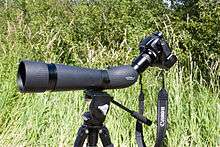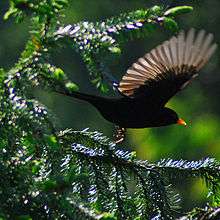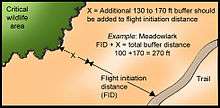Flight zone
The flight zone of an animal is the area surrounding an animal that if encroached upon by a potential predator or threat, including humans, will cause alarm and escape behavior; the flight zone is determined by the animal's flight distance (sometimes called flight initiation distance (FID))[3] which extends horizontally from the animal and sometimes vertically. It may also be termed flight initiation distance (FID), flush distance, or escape flight distance.
Swiss zoologist Heini Hediger distinguished between flight distance (run boundary), critical distance (attack boundary), personal distance (distance separating members of non-contact species, as a pair of swans), and social distance (intraspecies communication distance). Terms with similar concepts include escape distance and alert distance.
Flight distance can be used as a measure of the willingness of an animal to take risks.[4] Escape theory predicts that the probability of fleeing and flight distance increase as predation risk increases and decrease as escape cost increases.
In a study comparing 56 bird species with long flight distances, it was found these had declining populations Europe. This indicates that standardized measures of flight distance can provide reliable information about the population consequences of risk-taking behaviour by individuals and the susceptibility of different species to increased levels of disturbance by humans.[4]
When the flight zone of a group of bulls was invaded by a mechanical trolley, the bulls moved away and maintained a constant distance between themselves and the trolley.[5] This indicates animals sometimes maintain a flight zone around inanimate objects.
The alert distance (AD) is the distance, by definition greater, within which the animal changes its behaviour in a manner enabling it to better observe the stimulus, as by raising the head in an alert posture, but does not necessarily flee unless the stimulus is also within the escape distance.[6][7][8] These measures are usually used to quantify the tolerance of wildlife to humans.
Factors influencing size
Animals faced with approaching predators must decide at which distance to initiate their flight, and they are expected to do so in a way that maximizes their fitness. As flight has both costs (including lost opportunity) and benefits, there will be in general an optimal flight initiation distance, defined as the first point in a predator's approach at which the benefit of flight exceeds the cost. The benefit of flight is equivalent to the cost of remaining in place or, in other words, to the risk of capture. The size of the flight zone can therefore vary according to circumstances. However, it has been shown in burrowing owls that individuals showed high repeatability in their FID.[9]
- Behaviour of the threat: In horned lizards, FID decreased as the distance between a turning predator and prey increased, but was greater when the predator turned toward than away from the fleeing animal.[10] The FID and alert response of American robins to approaching humans was investigated; the greatest FID was when the approaching person was not on paths and was looking at the birds, while the lowest FID occurred when the person was on a path and not looking at the robins. The authors suggested this indicated that they use gaze direction to assess risk.[11]
- Social: In lizards, FID was shorter during social encounters than when they were solitary.[10] and FID was shorter in female lizards when they were interacting with males than when they were alone; it was also shorter in males interacting with either sex.[12]
- Distance to refuge: Gray squirrels (Sciurus carolinensis) typically run to the nearest tree to escape from predators. As the risk of capture increases with distance from the refuge tree, squirrels feeding far from trees should have greater FID than those feeding closer by. Confirming this, FID in response to a motorized model predator (a cat) increased as distance to refuge increased.[13] Burrowing Owls breeding in territories far from roads showed larger FIDs than individuals breeding closer to roads and mated owls showed similar FIDs. Individual owls showed high repeatability in their FID.[9]
- Training and learning: The size of the flight zone can depend upon the tameness or level of habituation of the animal. Completely tame animals have no flight zone for humans; that is, they will allow a person to approach and touch them. Wild, feral, and unbroken animals can have very large flight zones.
Wildlife management
Wildlife managers often use ED and FID to develop set-back distances to reduce human impacts on wildlife,[14][15][16][3] both in wildlife refuges, and, e.g., in planning areas for outdoor recreation.[17]
These measures are also important in birding and nature photography.
While escape distance has been generally used as a measure of tolerance, other changes in animal behavior in presence of humans, such as increased vigilance time at the cost of decreased feeding time, may have significant overall impact on wildlife. Therefore, it is suggested that a more conservative measure, namely, the alert distance, should be used in determining minimum approaching distance.[17] The latter typically adds a certain buffer distance to the given tolerance measure.[3]
Animal handling
The flight zone is an important principle for herding, working, and mustering livestock. An animal can be stimulated to move simply by skirting its flight zone, and the animal will move in the desired direction according to the point of balance. The point of balance is usually located at the animals shoulder according to their wide angled vision. An over-stimulated animal will have a larger flight zone, for example an excited or scared animal.[18] A Cumulative Flight Zone is formed when animals move in a herd. In this situation the lead animal and the following animals Points of Balance, within the cumulative flight zone, must both be crossed to entice movement.[18]
The flight distance during handling is usually 1.5 to 7.6 m for beef cattle raised in a feeding operation and up to 30 m on mountain ranges.[19] Brahman cattle have a larger flight zone than most English breeds.[20] The flight zone can be thought of as the animals personal space. The size of the flight zone is determined by the tameness of the animal; the more domesticated an animal, the smaller the zone. Fully tame animals have no flight zone.[21]
Studies with sheep indicated that animals confined in a narrow alley had a smaller flight zone compared to animals confined in a wider alley.[22]
Handlers sometimes make the mistake of deeply invading the flight zone when animals are being driven down an alley or into an enclosed area such as a crowd pen. If the handler deeply penetrates the flight zone, the animals may turn back and run over them in an attempt to escape.[23] Confining a livestock animal in a crush (chute) or alley can make it feel more secure and thus reduce the size of the flight zone; however, it does not eliminate the flight zone. An animal in a livestock raceway or alley that feels threatened may panic and injure itself or other animals.[24] If handlers lean over fences around animals they penetrate the "zone of safety" and may cause the animals to rear.[25]
Husbandry
Animals have a tendency to move in the opposite direction when their handler walks deep into their flight zone. By crossing an animal's point of balance, within the flight zone, a handler can move the herd in a particular direction and control their speed of movement. For example, crossing the point of balance from front to back will move the animal forwards, while the opposite is also true. The handler's pace should always reflect the animal's speed when herding. Additionally, pressure should be alternated on the flight zone to reduce stress.[21] Constant pressure should never be applied.
If animals turn to face the handler he or she is considered to be no longer penetrating the flight zone.[21]
It is important that a handler does not pursue any struggling animals as this will cause undue stress. Instead the animal should be allowed to return to the group as animals naturally have herd instincts, and will follow the groups leader. A good herding practice applying this is the movement of animals through a race by maintaining a steady flow of animals, not herding in groups, this allows new animals to follow the leader calmly.[26] When yarded, animals should always have room to turn away from the handler to reduce stress. Minimal stress prevents injury to the animal and maintains good production, such as increased quality of meat and improved muscle and fat scores.[24]
Appropriate frequent penetration of the flight zone can train the animals to minimise their flight zone to the handler.[21]
Poor husbandry skills including over penetration of the flight zone results in the following behaviours: stress, panic, aggression, bolting, prey behaviour, charging, fainting, sickness and self-inflicted damage. Rough handling, such as constant flight zone pressure, can raise the heart rate of an animal. These factors are all reflective of the General Adaptation Syndrome.
General Adaptation Syndrome
The general adaptation syndrome (GAS) is a three-phase response to stress in animals.
- The first phase is the fight or flight response - the animal flight zone is included in this. Over penetration of the animal flight zone causes stimulation of the sympathetic nervous system (SNS). The SNS produces localised adjustments and responses; this includes the excretion of large quantities of epinephrine from the medulla of the adrenal gland.[27] Epinephrine is commonly known as adrenaline. Adrenaline increases the supply of oxygen to vital organs and decreases supply to others.[28] Frequent subjection to fight or flight situations causes severe endocrine disorders.
- The second phase is Adaptation and Resistance. It is the idea that recurring subjection builds natural immunity.[28] This refers to the concept that common handler movement and herding minimises an animals flight zone.
- The third phase is Exhaustion. Strong, constant and over frequent stimulation of an animals flight zone may lead to death, decreases production and lower quality of life. According to the GAS, a full recovery from exhaustion is possible over time.[28]
Escape distance
Sample values
Sample escape distances (mostly mean) from humans:
Birds of Europe

| Species | ED [m] | Ref. |
|---|---|---|
| Brant goose Branta bernicla | (130-1000) 319 | [7] |
| Pintail Anas acuta | (100-500) 294 | [7] |
| Grey heron Ardea cinerea | 255 | [8] |
| Mallard Anas platyrhynchos | (60-400) 236 | [7] |
| Lapwing Vanellus vanellus | 162 | [8] |
| Dunlin Calidris alpina | (15-450) 70 | [7] |
| Coot Fulica atra | 68 | [8] |
| Whinchat Saxicola rubetra | 20-30 | [29] |
| Blackbird Turdus merula | 10 | [29] |
| Blue tit Cyanistes caeruleus | 10 | [29] |
Birds of North America [3]
|
Mammals of North America [3]
|
Factors affecting escape distances for birds

Escape distance may differ significantly depending on many circumstances.
- Species [7][6][15][14][8][29] - for example mallard Anas platyrhynchos has shorter ED than pintail Anas acuta[7].
moreover:
- Age - young birds are less shy, for example dunlin Calidris alpina )
- Location or rather habituation to walking people. [7] Mallards Anas platyrhynchos or Canada Geese Branta canadensis are less shy in a park than somewhere in the wild. Or Tits and Nuthatches near the feeder or in the park are less shy than in the wild.
- Season. For example, wintering bullfinches Pyrrhula pyrrhula have shorter EDs than breeding ones. [29]
- Origin of birds - sometimes wintering birds from the north, perhaps not knowing people, are less shy than native, for example nutcracker Nucifraga caryocatactes [29]
- Given bird individual
- Color of clothes of an observer and observer's behaviour [29]
- Hunting status - quarry species have longer EDs than non-quarry, increasing during hunting season or after days with hunting. [7][8]
- Flock size [8]
- Flock composition - for example birds in mixed flocks of mallard Anas platyrhynchos and teal Anas crecca react at longer distances than those in single species flocks for either species. [8] Or dunlin Calidris alpina in flocks with other waders. [29]
- Visibility of the stimulus to the birds[8]
- Wind force [7]
- Vegetation height [8]
See also
- Birdwatching
- Digiscoping
- Fight-or-flight response
- Nature photography
- Personal space
- Wildlife photography
References
- ↑ Bentrup G. (2008). "Conservation buffers: design guidelines for buffers, corridors, and greenways.". Gen. Tech. Rep. Asheville, NC: USDA, Forest Service, Southern Research Station. SRS-109.
- ↑ Bentrup, G. (2008). "Flight Initiation Distance Buffers". USDA National Agroforestry Center. Retrieved September 6, 2012.
- 1 2 3 4 5 Bentrup, G. (2008). "Flight Initiation Distance Buffers". USDA National Agroforestry Center. Retrieved September 6, 2012.
- 1 2 Moller, A.P., (2008). Flight distance and population trends in European breeding birds. Behavioral Ecology, 19: 1095-1102
- ↑ Kilgour, R., (1971). Animal handling in works, pertinent behaviour studies. 13th Meat Industry Research Conference, Hamilton, New Zealand. pp. 9-12
- 1 2 Ruddock M., Whitfield D. P. (2007). "A Review of Disturbance Distances in Selected Bird Species, A report from Natural Research (Projects) Ltd to Scottish Natural Heritage" (PDF). Retrieved September 4, 2012.
- 1 2 3 4 5 6 7 8 9 10 11 Laursen K., Kahlert J., Frikke, J. (2005). "Factors affecting escape distances of staging waterbirds" (PDF). Wildlife Biology. 11 (1): 13–19. doi:10.2981/0909-6396(2005)11[13:faedos]2.0.co;2. Retrieved September 4, 2012.
- 1 2 3 4 5 6 7 8 9 10 11 Bregnballe T., Aaen K., Fox A. D. (2009). "Escape distances from human pedestrians by staging waterbirds in a Danish wetland" (PDF). Wildfowl. Special Issue 2: 115–130. Retrieved September 4, 2012.
- 1 2 Carrete, M. and Tella, J.L. (2009). Individual consistency in flight initiation distances in burrowing owls: a new hypothesis on disturbance-induced habitat selection. Biology Letters, 6: 167-170 doi: 10.1098/rsbl.2009.0739
- 1 2 Cooper, W.E. (2000). "Plesiomorphic escape decisions in cryptic horned lizards (Phrynosoma) having highly derived antipredatory defenses". Retrieved April 20, 2013.
- ↑ Eason, P.K., Sherman, P.T, Rankin, O. and Coleman, B., (2006). Factors affecting flight initiation distance in American robin. The Journal of Wildlife Management, 70: 1796–1800
- ↑ Cooper, W.E., (2009). Flight initiation distance decreases during social activity in lizards (Sceloporus virgatus). Behavioral Ecology and Sociobiology, 63: 1765-1771
- ↑ Dill, L.M. and Houtman, R., (1989). The influence of distance to refuge on flight initiation distance in the gray squirrel (Sciurus carolinensis). Canadian Journal of Zoology, 67: 233-235
- 1 2 Fernandez-Juricic E., Jimenez M. D. , Lucas E. (2001). "Alert distance as an alternative measure of bird tolerance to human disturbance- implications for park design" (PDF). Environmental Conservation. 28 (3): 263–269. doi:10.1017/S0376892901000273. Retrieved September 4, 2012.
- 1 2 Blumstein D. T. (Oct 2003). "Flight-Initiation Distance in Birds Is Dependent on Intruder Starting Distance" (PDF). The Journal of Wildlife Management. Allen Press. 67 (4): 852–857. doi:10.2307/3802692. Retrieved September 4, 2012.
- ↑ Bentrup G. (2008). "Conservation buffers: design guidelines for buffers, corridors, and greenways.". Gen. Tech. Rep. Asheville, NC: USDA, Forest Service, Southern Research Station. SRS-109.
- 1 2 Alert distance as an alternative measure of bird tolerance to human disturbance: implications for park design
- 1 2 Grandin, Temple. "Behavioural Principles of Livestock Handling". Vision, Hearing, and Handling methods in Cattle and Pigs. American Registry of Professional Animal Scientists. Retrieved 7.10.13. Check date values in:
|access-date=(help) - ↑ Grandin, T., (1980). Observations of cattle behavior applied to the design of cattle-handling facilities. Appl. Anim. Ethol. 6: 19-31
- ↑ Grandin, T. (1978). Observations of the spatial relationships between people and cattle during handling. Proc. Western Sect., Am. Soc. Anim. Sci. 29: 76-79
- 1 2 3 4 Grandin, Temple. "Behavioural Principles of Livestock Handling". Vision, Hearing, and Handling methods in Cattle and Pigs. American Registry of Professional Animal Scientists. Retrieved 7.10.13. Check date values in:
|access-date=(help) - ↑ Hutson, G.D. (1982). Flight distance in Merino sheep. Animal Production, 35: 231-235
- ↑ Grandin T. (1989). "Behavioral principles of livestock handling". Retrieved April 22, 2013.
- 1 2 Chambers, P.G.; Grandin, T.; Heinz, G.; Srisuvan, T. (2001). "Guidelines for Humane Handling, Transport and Slaughter of Livestock". Food and Agriculture Organization of the United Nations – Regional Office for Asia and the Pacific. Retrieved April 22, 2013.
|chapter=ignored (help) - ↑ Grandin, T. (1983). Handling and processing feedlot cattle. In: G.B. Thompson and C.C. O'Mary (Eds) The Feedlot, Lea & Febiger, Philadelphia. pp. 213-235
- ↑ Grandin, Temple. "Understanding Flight Zones and Point of Balance". ProWay Livestock Equipment. Retrieved 7.10.13. Check date values in:
|access-date=(help) - ↑ Loewy, Arthur. "Human Nervous System". Britannica. Retrieved 7.10.13. Check date values in:
|access-date=(help) - 1 2 3 Unknown, Unknown. "General Adaptation Syndrome". Oracle Education Foundation. Retrieved 7.10.13. Check date values in:
|access-date=(help) - 1 2 3 4 5 6 7 8 Gotzman J., Desselberger J. (1979). Z lornetką wśród ptaków [With binoculars among birds]. Nasze hobby [Our hobby] (in Polish) (1st ed.). Warsaw: Państwowe Wydawnictwo Rolnicze i Leśne (PWRiL).
Further reading
Cooper, W.E. and Frederick, W.G. (2007). Optimal flight initiation distance. Journal of Theoretical Biology, 244: 59–67
